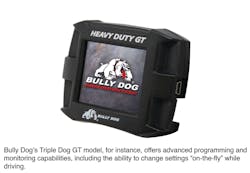"Pushing the limits is what wins championships," according to Ted Kravitz of Sky Sports F1 HD News. No less competitive is the heavy-duty trucking industry, where owner/operators and fleet managers must race to stay ahead of rising diesel prices, regulations, and rivals. Seeking that extra edge, many truckers are turning to an emerging technology in the form of gauge tuners that coax maximum performance from their engines to yield significant fuel savings.
"I have seen a notable increase in fuel economy with the gauge tuner unit we have; about 15 percent," says Joe Parks, general manager of Romulus, Michigan-based Pilot Transport-a division of United Road Services Inc. United Road is the premier auto transport company in North America, transporting nearly 2 million cars for all major global vehicle manufacturers.
For any fleet like that of Pilot Transport, which operates several trucks, the savings add up quickly.
"Right now, our fuel costs are about 72 cents per mile," Parks continues. "We mounted a gauge tuner on one truck and saved about 8 cents a mile. Since we run about 600,000 miles a month, potentially, the monthly savings could be huge [$0.08 x 600,000 = $48,000]. In the particular model tractor that we have, it would be worth the expense to mount these units in all the trucks with that engine."
Shrinking profit margins require increasingly proactive solutions
Spiraling diesel fuel costs have impacted the U.S.trucking industry in dramatic fashion. The rapid rise from $2.80 a gallon in 2008 to the current average of $4.50 per gallon has forced some firms into bankruptcy and many owner/operators to sell their rigs. With the cost of a fill-up for an 18-wheeler well over $1,000, fuel now surpasses labor as the biggest cost for some trucking firms.
The key to maintaining competitiveness in this economy is to improve operating efficiency. Toward this end, original equipment manufacturers have designed new trucks with improved fuel economy in mind. However, the engineers who design these engines must hold back for two reasons, according to Bully Dog.
First of all, OEM manufacturers often produce only a few engine designs which are used in a wide range of models and platforms, allowing them to sell vehicles in a greater number of markets. This saves them money, but at the expense of creating an optimized engine management system for every application, according to Bully Dog.
Secondly, manufacturers are increasingly forced to "detune" their engines, which leaves extra horsepower "on the table," so efficiency suffers as well as mileage.
Harnessing technology to the open road
Previously used in automotive applications, engine performance tuners-known more generally as programmers are now finding their way into the trucks and fleets of early-adopting owners and managers to improve performance in diesel applications.
Consisting of a compact control panel, gauge tuners are easily connected to the engine's control module with wire leads. They operate by monitoring turbo boost pressure, engine RPMs, coolant temperature, air flow, fuel rail pressure and other operating considerations such as vehicle load, and then balancing these parameters by changing the electronic tuning characteristics of the engine management system to yield optimized performance.
"These tuners boost power and torque, but improved fuel mileage is the main advantage; about 15% more miles per gallon," says Dave Brown of Piedmont Peterbuilt, LLC in Greensboro, North Carolina-a leading dealer of new Peterbilts, used trucks and aftermarket trucking products. "Our customers who have installed the tuners tell us there's a 90-day payback on them."
The appeal of installing these new tuners has greatly increased with the availability of models that simply re-flash the existing mapping of the engine control module without modification to engine hardware, according to Bully Dog.
"We sell the Bully Dog tuners because anybody with only a little knowledge of computers can sit in their cab and install one," says Brown. "With older tuning options you had to take the engine control module off and send it somewhere else to have it worked on, which meant extra downtime. But with the newer designs like Bully Dog you just plug it in and follow the prompts on the screen."
Since 1998, American Falls, Idaho-based Bully Dog Technologies has been designing and refining industry-leading tuners for automotive, and more recently, middle and heavy duty trucking applications. The single unit provides four functions: engine tuner, function monitor, performance gauge and diagnostic device.
Such modern units are now located in the cab of the vehicle, such as on top of the dash, as opposed to older designs which were situated in the engine compartment where heat, cold, humidity and vibration could cause failures in the tuner and potentially result in an engine malfunction.
"We've experimented with different products, tried various things for performance and mileage, but this is by far the best thing I've ever come across," notes Brown.
Pushing the envelope, safely
Modern gauge tuners also provide a set of diagnostic functions that enhance safety.
For example, if the engine coolant or oil starts to overheat, the gauge tuner can automatically recognize the condition. The device can also alert the driver with a message on the panel display that notifies the driver what is happening and why. This helps the driver evaluate if it's a critical situation requiring immediate repair, or if he can complete his run and get the problem resolved later.
"The Bully Dog units, for one, supply real-time coolant temperature, as opposed to the OEM gauges which often only alert you after the engine is already overheating," notes Brown. "Other real-time monitoring features help the drivers visualize performance at any time."
Some of the latest gauge tuners even have a built-in driving coach that offers tips that help develop positive driving habits to improve fuel economy. According to Edmunds, driving habits can increase economy by up to 37 percent.
"The Bully Dog unit will definitely help newer drivers: telling you where your power is at and when to shift," says Pilot Transport's Parks. "We're definitely seeing a performance boost. The driver said he's pulling hills better."
"I've had people who've been driving for years, who told me they were good drivers, but they've come back later and told me that it has actually educated them," says Brown.
In another nod toward safety, some gauge tuners offer the ability to preset a maximum speed limit. By itself this forces further fuel savings, and across an entire fleet, the cost savings mount rapidly.
"Over the years, we get approached with products and promises that never pan out, so the industry is kind of numb," Parks acknowledges. "Our driver who had the tuner installed was a little skeptical at first, but now he really likes it. Until you try it, you really don't know how good it is."

